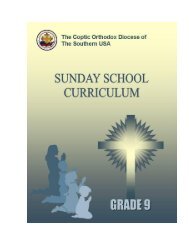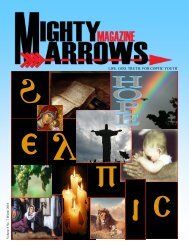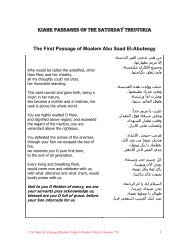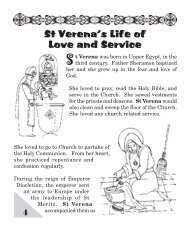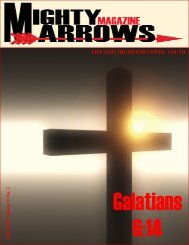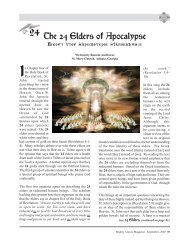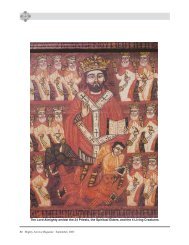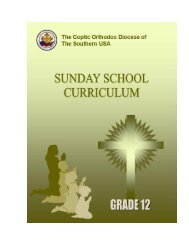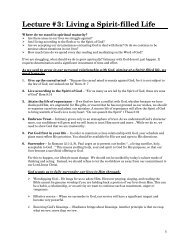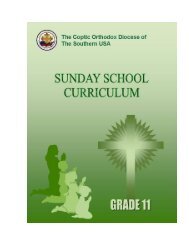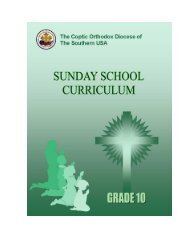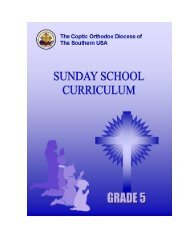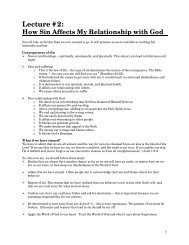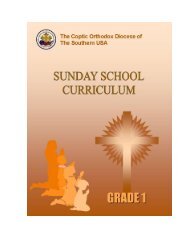Create successful ePaper yourself
Turn your PDF publications into a flip-book with our unique Google optimized e-Paper software.
Holiness <strong>of</strong> Hymns and Purity <strong>of</strong> Praises<br />
<strong>The</strong> <strong>Divine</strong> <strong>Liturgy</strong> <strong>of</strong> <strong>St</strong> <strong>Mark</strong> and<br />
<strong>The</strong> Origin <strong>of</strong> the <strong>Divine</strong> <strong>Liturgy</strong><br />
Pivwsen n~nou] n~te v/eyouab <strong>Mark</strong>oc<br />
Written by: George Guirguis<br />
<strong>St</strong> <strong>Mark</strong>, Houston, TX<br />
Introduction<br />
<strong>The</strong> <strong>Divine</strong> <strong>Liturgy</strong> <strong>of</strong> <strong>St</strong>. <strong>Mark</strong> is the ancient, traditional<br />
original <strong>Divine</strong> <strong>Liturgy</strong> <strong>of</strong> the Orthodox Church <strong>of</strong><br />
Alexandria. With the discovery <strong>of</strong> a papyrus from the end<br />
<strong>of</strong> the fourth century in 1928, currently kept at <strong>St</strong>rasburg<br />
University, it also has the most ancient documentation <strong>of</strong><br />
any Orthodox <strong>Divine</strong> <strong>Liturgy</strong> still in use. Besides the Coptic<br />
Orthodox Church, other Orthodox Churches use it in their<br />
prayers. 1<br />
This <strong>Divine</strong> <strong>Liturgy</strong> was instituted by our founding father,<br />
<strong>St</strong> <strong>Mark</strong> the Apostle, the evangelist <strong>of</strong> the land <strong>of</strong> Egypt.<br />
It is one <strong>of</strong> three <strong>Divine</strong> Liturgies utilized in the Coptic<br />
Church today: the <strong>Divine</strong> <strong>Liturgy</strong> <strong>of</strong> <strong>St</strong> Basil, the <strong>Divine</strong><br />
<strong>Liturgy</strong> <strong>of</strong> <strong>St</strong> Gregory and the <strong>Divine</strong> <strong>Liturgy</strong> <strong>of</strong> <strong>St</strong> Cyril.<br />
<strong>St</strong> Cyril, the 24 th Pope <strong>of</strong> the See <strong>of</strong> <strong>St</strong> <strong>Mark</strong>, who is known<br />
as the ìPillar <strong>of</strong> the Faith,î added some litanies to the<br />
original text so the <strong>Divine</strong> <strong>Liturgy</strong> <strong>of</strong> <strong>St</strong> <strong>Mark</strong> is also known<br />
as the <strong>Divine</strong> <strong>Liturgy</strong> <strong>of</strong> <strong>St</strong> Cyril.<br />
This <strong>Divine</strong> <strong>Liturgy</strong> is the origin <strong>of</strong> other liturgies such as<br />
the <strong>Divine</strong> Liturgies <strong>of</strong> <strong>St</strong> Basil and <strong>St</strong> Gregory, and the<br />
<strong>Liturgy</strong> <strong>of</strong> the Apostles used by the Ethiopian Church. 2<br />
Origin <strong>of</strong> the liturgy<br />
<strong>The</strong> first <strong>Liturgy</strong> <strong>of</strong>ficiated by the apostles was more or<br />
less the <strong>Liturgy</strong> <strong>of</strong> the Last Supper, <strong>of</strong>ficiated by Our Lord.<br />
In it, Our Lord completed three main acts, which together<br />
constitute one action, the ìEucharistî<br />
First: Ritual act<br />
In it, Our Lord practiced the Jewish rites <strong>of</strong> the ìAgapeî<br />
which is breaking <strong>of</strong> the bread followed by supper and then<br />
blessing God (<strong>of</strong>fering thanksgiving to Him) on the Chalice<br />
and finally praises. 3<br />
Second: Mystical act<br />
In it, Our Lord simply declared after the blessing on the<br />
bread and distributing it that this is His Body and on the<br />
wine that this is His Blood. He then ordered his disciples<br />
to do this for His remembrance.<br />
Third: Explanatory Act<br />
In it, Our Lord explained the aspects <strong>of</strong> the converted Body<br />
and Blood.<br />
How the church completed the three actions<br />
<strong>The</strong> Agape and the Eucharist<br />
First: ritual act<br />
This was simple, they just repeated the same sequence done<br />
in the Last Supper, first in the Upper Room and then later in<br />
homes after the number <strong>of</strong> the Christians increased.<br />
Second: <strong>The</strong> Mystical<br />
<strong>The</strong> church faced some difficulty in the beginning. Our Lord<br />
Jesus Christ in the Last Supper simply converted the body<br />
and blood by the power <strong>of</strong> His Divinity, with no special<br />
prayers. He just said, ìTake eat, this is My Bodyî (Matt<br />
26:26). <strong>The</strong> conversion was simply by the Word <strong>of</strong> God.<br />
<strong>The</strong>y had then to add somewhere in the <strong>Liturgy</strong> a plea for<br />
the ìpresence <strong>of</strong> the Lord Jesus Christî so that He can make<br />
this change Himself.<br />
Third: Explanatory<br />
In the beginning, there was no formal form for the prayers.<br />
<strong>The</strong> bishop or priest, heading the Agape and the <strong>Divine</strong><br />
<strong>Liturgy</strong> in one <strong>of</strong> the houses, would say some prayers and<br />
do some explanation for the people attending. With the<br />
spread <strong>of</strong> the service and increase in number <strong>of</strong> the believers,<br />
these prayers had to be formulated to explain every move,<br />
especially after the entrance <strong>of</strong> the gentiles in Christianity.<br />
So this was beginning <strong>of</strong> the <strong>Divine</strong> <strong>Liturgy</strong>. Later, the<br />
bishops in different churches added some parts to the <strong>Divine</strong><br />
Liturgies. Mainly some litanies, necessitated by their times<br />
and explanation <strong>of</strong> the story <strong>of</strong> salvation.<br />
Time <strong>of</strong> writing the <strong>Divine</strong> <strong>Liturgy</strong> <strong>of</strong> <strong>St</strong> <strong>Mark</strong><br />
Most <strong>of</strong> the famous rites scientist thinks the <strong>Divine</strong> <strong>Liturgy</strong><br />
Mighty Arrows Magazine November, 2002 33
Holiness <strong>of</strong> Hymns and Purity <strong>of</strong> Praises<br />
<strong>of</strong> <strong>St</strong> <strong>Mark</strong> together with other ancient<br />
liturgies (<strong>Liturgy</strong> <strong>of</strong> <strong>St</strong> James, <strong>Liturgy</strong> <strong>of</strong> <strong>St</strong><br />
Clement present in the Didache) was written<br />
in the third century. 4 This means that even if<br />
they were not written by the apostles<br />
themselves, we can surely say that these are<br />
the exact word <strong>of</strong> these apostles, carried down<br />
through the spoken tradition.<br />
Parts <strong>of</strong> the <strong>Liturgy</strong><br />
Any <strong>Liturgy</strong> constitutes four basic parts:<br />
1- Introduction to the <strong>Liturgy</strong> called<br />
Preface.<br />
2- <strong>The</strong> Praise <strong>of</strong> the Cherubim called<br />
<strong>St</strong> <strong>Mark</strong><br />
Pro Sanctus.<br />
<strong>St</strong> <strong>Mark</strong><br />
3- Institution: which are the words <strong>of</strong><br />
the Lord on the Bread and Wine.<br />
4- Invocation or Epiclesis, which is calling <strong>of</strong> the Holy<br />
Spirit or the Word to bless the bread and wine to<br />
the Body and Blood.<br />
3. Thanksgiving for Creation <strong>of</strong> Heaven<br />
and Earth<br />
ì You are He who has created the heavens and<br />
that which is in the heavens, the earth and<br />
everything that is therein: the seas, the rivers,<br />
the springs, the lakes, and that which is in all<br />
<strong>of</strong> them.<br />
4. Thanksgiving for the Offering <strong>of</strong> the<br />
Sacrifice<br />
ìthrough whom we give thanks and <strong>of</strong>fer unto<br />
You, with Him and the Holy Spiritóthe holy,<br />
co-essential, and undivided Trinityóthis<br />
rational sacrifice and this bloodless service.î<br />
<strong>The</strong> Litanies<br />
<strong>The</strong> litanies in the <strong>Divine</strong> <strong>Liturgy</strong> <strong>of</strong> <strong>St</strong> <strong>Mark</strong><br />
come before the Invocation. This was the original place for<br />
the litanies and then was moved later after the descent <strong>of</strong><br />
the Holy Spirit in later <strong>Divine</strong> Liturgies, like <strong>St</strong> Basilís and<br />
<strong>St</strong> Gregoryís.<br />
<strong>The</strong> <strong>Divine</strong> <strong>Liturgy</strong> <strong>of</strong> <strong>St</strong> <strong>Mark</strong> has its own characteristics.<br />
It is kept by the Church <strong>of</strong> Alexandria in original form. <strong>The</strong><br />
sequence <strong>of</strong> the different parts may seem different than other<br />
liturgies for that reason.<br />
<strong>The</strong> Preface:<br />
1. It starts with a dialogue between the priest and the<br />
people:<br />
<strong>The</strong> Lord be with you all And with your spirit.<br />
Lift up your hearts We have them with the Lord.<br />
Let us give thanks to the Lord It is meet and right.<br />
(This is an invitation to the Eucharist: Thanksgiving)<br />
2. Meet and right<br />
We notice here the abundant number <strong>of</strong> the verbs <strong>of</strong><br />
praise. ìto praise You, hymn You, bless You, serve<br />
You, worship You, give thanks to You, and glorify<br />
You, And confess to You night and day, with unfailing<br />
lips, with a heart that keeps not silent, and with<br />
unceasing glorifications.î <strong>The</strong> priest here is switching<br />
between the sacrifice <strong>of</strong> the body and blood to the<br />
sacrifice <strong>of</strong> praise (the last response said by the people:<br />
ìA mercy <strong>of</strong> peace, a sacrifice <strong>of</strong> praise.î<br />
<strong>The</strong> Praise <strong>of</strong> the Cherubim (Sanctus)<br />
ìFor You are God, who are above every principality and<br />
every authority, and every power and every dominion, and<br />
every name that is named, not only in this age, but also in<br />
that which is to come. You are He before whom stand<br />
thousands <strong>of</strong> thousands and ten thousand times ten thousand<br />
<strong>of</strong> holy angels and archangels, serving YouÖ.í<br />
This praise was first added to the Eucharist in Egypt,<br />
specifically Alexandria before year 230 AD, and from Egypt<br />
to the end <strong>of</strong> the world.<br />
<strong>The</strong> Short Invocation<br />
<strong>The</strong> priest signs the paten and the chalice together once,<br />
while saying: ìFill this, Your sacrifice, O Lord, with the<br />
blessing, which is from You, by the coming down upon it <strong>of</strong><br />
Your Holy Spirit.î<br />
<strong>The</strong> Institution<br />
<strong>The</strong>se are the words <strong>of</strong> the Lord in the Last Supper when<br />
He instituted the New Covenant with his Blood.<br />
34 Mighty Arrows Magazine November, 2002
Holiness <strong>of</strong> Hymns and Purity <strong>of</strong> Praises<br />
ìin the night in which He gave Himself up that He might<br />
suffer for our sinsó and death, which He accepted by His<br />
own will for us allóHe took bread into His holy hands which<br />
are without spot, or blemish, blessed, and life-givingÖ..î<br />
<strong>The</strong> Great Invocation<br />
This is the third invocation: <strong>The</strong> first is an invocation to the<br />
Holy Trinity in the Rites <strong>of</strong> the Offering <strong>of</strong> the Lamb (in the<br />
very beginning <strong>of</strong> the <strong>Divine</strong> <strong>Liturgy</strong>), the second is an<br />
invocation for the Son (the short invocation) and this one is<br />
for the Holy Spirit. In all three, it is the same petition to<br />
God to change the bread and wine to the Body and Blood <strong>of</strong><br />
our Lord.<br />
<strong>The</strong> Fraction<br />
This is the ìBreaking <strong>of</strong> the Breadî, one <strong>of</strong> the main part <strong>of</strong><br />
the original liturgies. Our Lord, after He blessed the bread,<br />
He broke it and gave it to His disciples.<br />
<strong>The</strong> Elevation, Consignation and Commixture<br />
<strong>The</strong> despotikon (means ìfor the Lordî) is the middle part <strong>of</strong><br />
the bread. <strong>The</strong> priest takes the despotikon and with It he signs<br />
the precious Blood inside the chalice in the form <strong>of</strong> the cross.<br />
<strong>The</strong>n he dips the extremity <strong>of</strong> It inside the chalice and carefully<br />
raises It soaked in the Blood, and with It signs, in the form <strong>of</strong><br />
the cross, the pure Body which is all on the paten. This is a<br />
symbol <strong>of</strong> the unity <strong>of</strong> the Body and Blood.<br />
1<br />
http://www.odox.net/<strong>Liturgy</strong>1-<strong>Mark</strong>.htm<br />
2<br />
J. M. Neale, General Introduction, p 324, cited by A.N.F.,<br />
VII, p534<br />
3<br />
John 13<br />
4<br />
Rev. William Palmer, ìOrigines Liturgicaneî, Oxford,<br />
1832.<br />
Saint <strong>Mark</strong><br />
Anianous<br />
Milious<br />
Kerdonous<br />
Ebrimous<br />
Yostous<br />
Omanious<br />
Marcianos<br />
Kalawtianos<br />
Eghribanos<br />
Youlianos<br />
Demetrius I<br />
Yaraklas<br />
Dionisious<br />
Maximous<br />
Thaona<br />
Peter I<br />
Archilaous<br />
Alexandros<br />
Athanasious I<br />
In Succession <strong>of</strong> Saint <strong>Mark</strong><br />
Below is a list <strong>of</strong> all our Fathers, the patriarchs <strong>of</strong> the Coptic Orthodox Church, starting from its establishment.<br />
Peter II<br />
Timothy I<br />
<strong>The</strong>ophilos<br />
Kyrillos I<br />
Dioscorous I<br />
Timothy II<br />
Peter III<br />
Athanasious II<br />
Youannes I<br />
Youannes II<br />
Dioscorous II<br />
Timothy III<br />
<strong>The</strong>odosious I<br />
Peter IV<br />
Demianos<br />
Anastasious<br />
Andrenicous<br />
Benjamin I<br />
Agathou<br />
Youannes III<br />
Isaac<br />
Simeon I<br />
Alexandrous II<br />
Kosma I<br />
<strong>The</strong>odorous<br />
Kaeil I<br />
Mina I<br />
Youannes IV<br />
<strong>Mark</strong> II<br />
Jacob<br />
Simeon II<br />
Yousab I<br />
Kaeil II<br />
Kosma II<br />
Shenouda I<br />
Michael I<br />
Gabriel I<br />
Kosma III<br />
Makarious I<br />
<strong>The</strong>ophanious<br />
Mina II<br />
Abraam<br />
Philotheous<br />
Zacharius<br />
Shenouda II<br />
Christotholous<br />
Kyrillos II<br />
Michael II<br />
Makarious II<br />
Gabriel II<br />
Michael III<br />
Youannes V<br />
<strong>Mark</strong> III<br />
Youannes VI<br />
Kyrillos III<br />
Athanasius III<br />
Gabriel III<br />
Youannes VII<br />
<strong>The</strong>odosius III<br />
Youannes VIII<br />
Youannes IX<br />
Benjamin II<br />
Peter V<br />
<strong>Mark</strong> IV<br />
Youannes X<br />
Gabriel IV<br />
Metaous I<br />
Gabriel V<br />
Youannes XI<br />
Metaous II<br />
Gabriel VI<br />
Michael IV<br />
Youannes XII<br />
Youannes XIII<br />
Gabriel VII<br />
Youannes XIV<br />
Gabriel VIII<br />
<strong>Mark</strong> V<br />
Youannes XV<br />
Metaous III<br />
<strong>Mark</strong> VI<br />
Metaous IV<br />
Youannes XVI<br />
Peter VI<br />
Youannes XVII<br />
<strong>Mark</strong> XVII<br />
Youannes XVIII<br />
<strong>Mark</strong> VIII<br />
Peter VII<br />
Kyrillos IV<br />
Demetrious II<br />
Kyrillos V<br />
Youannis XIX<br />
Makarious III<br />
Yousab II<br />
Kyrillos VI<br />
Pope Shenouda III<br />
Pope <strong>of</strong> Alexandria<br />
Patriarch <strong>of</strong> the See<br />
<strong>of</strong> Saint <strong>Mark</strong><br />
Mighty Arrows Magazine November, 2002 35



